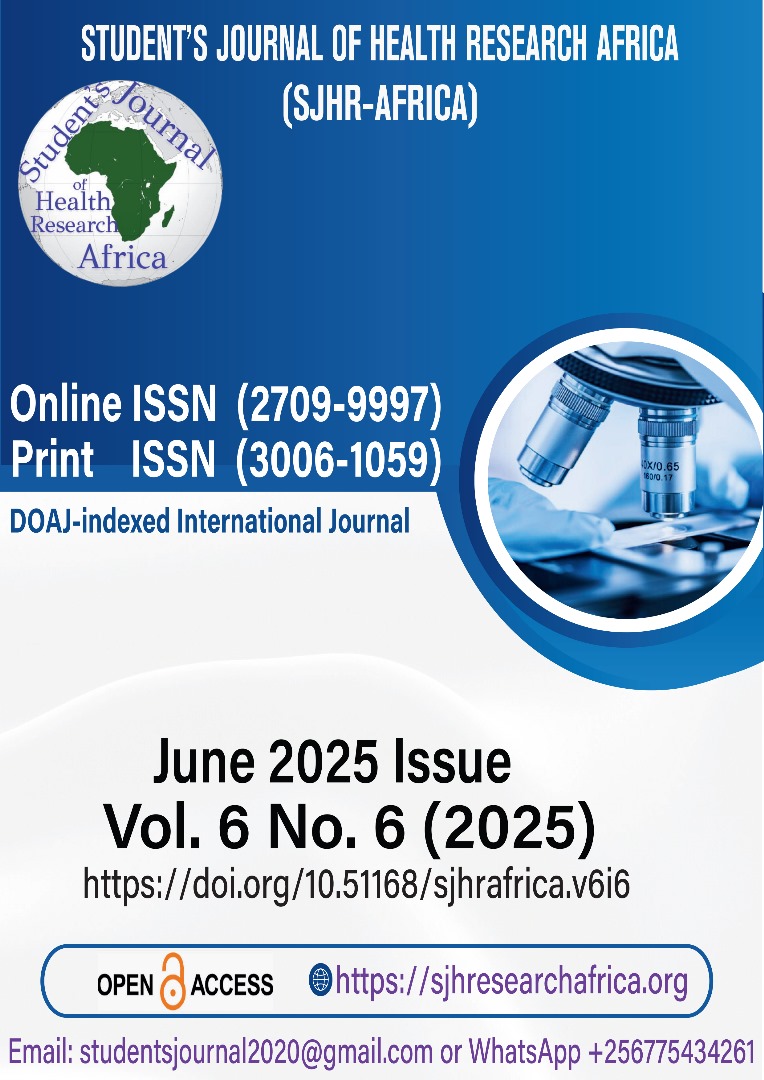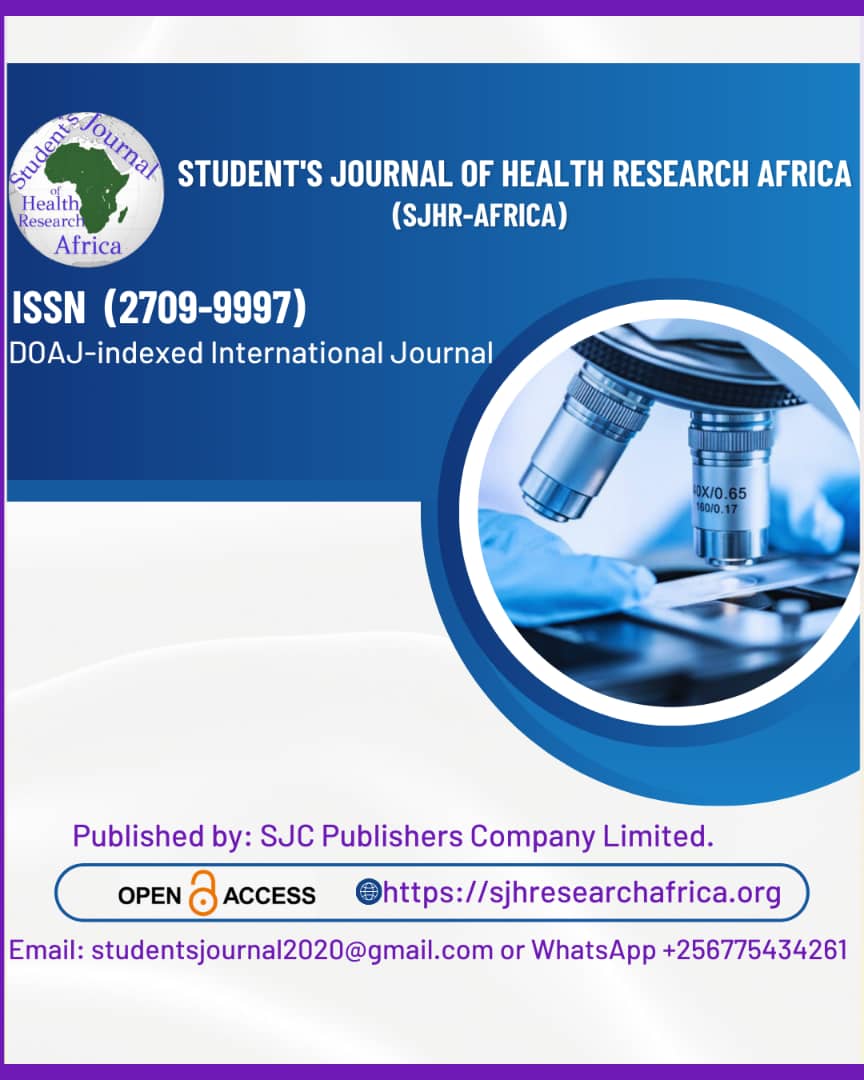THE PREVALENCE OF CRYPTOCOCCAL MENINGITIS IN HIV POSITIVE PATIENTS THAT ARE ON ANTIRETROVIRAL TREATMENT. A RETROSPECTIVE QUANTITATIVE STUDY PERFORMED AT DURBAN ADDINGTON HOSPITAL IN KZN, SOUTH AFRICA.
DOI:
https://doi.org/10.51168/sjhrafrica.v6i6.1627Keywords:
HIV, Antiretroviral, Cryptococcal meningitis, Cerebrospinal fluidAbstract
Introduction
HIV remains a global health challenge, with approximately 37.7 million people living with HIV in South Africa by 2020 (WHO). Among HIV-positive individuals, Cryptococcal meningitis (CM), a severe opportunistic infection, is a leading cause of morbidity and mortality. Despite the widespread use of antiretroviral therapy (ART), CM continues to be a major concern, especially in sub-Saharan Africa, where HIV prevalence is high.
Aims and Objectives
This study aimed to determine the prevalence of CM in HIV-positive patients on ART at Durban Addington Hospital between January and July 2022. The findings are intended to inform health practitioners on prevention strategies and treatment needs for this group.
Methodology
A retrospective quantitative approach was employed, analyzing medical and laboratory data from 137 HIV-positive patients. Cerebrospinal fluid (CSF) samples were tested for Cryptococcus neoformans, and the results were correlated with CD4 count and viral load data. This approach facilitated a statistical exploration of CM prevalence in HIV patients on ART.
Results
The study found that the majority of the participants were aged between 18 and 39 years. 17 patients (12.4%) tested positive for Cryptococcal antigen, indicating active CM infection. A significant portion of the cohort had low CD4 counts, putting them at higher risk for opportunistic infections. Additionally, 105 (76.6%) patients exhibited inadequate viral suppression, suggesting issues with ART adherence or treatment failure.
Conclusion
The study found a low prevalence of CM in HIV-positive patients on ART at Durban Addington Hospital. However, the high rate of advanced immunosuppression (low CD4 counts and high viral loads) highlights challenges in managing these patients and the need for improved diagnostic and monitoring practices.
Recommendations
Further longitudinal studies on adherence interventions, ART optimization, and integrated HIV care for opportunistic infections are recommended.
References
Ahmed, M.Z., Rao, T., Saeed, A., Mutahir, Z., Hameed, S., Inayat, S., Shahzad, H., Ullah, N., Abaid-Ullah, M., Ibrahim, M. and Munir, S., 2021. Antifungal drugs: mechanism of action and resistance. Biochemistry of Drug Resistance, pp.143-165 https://doi.org/10.1007/978-3-030-76320-6_5
Ahmed, A.A., Zakaria, Z., Ali, M.H., Pusppanathan, J., Rahim, R.A., Muji, S.Z.M., Noor, A.M., Rahiman, M.H.F., Hassan, M.K.A., Safar, M.J.A. and Salleh, A.F., 2021. Single Channel Magnetic Induction Measurement for Meningitis Detection. In Intelligent Manufacturing and Mechatronics: Proceedings of SympoSIMM 2020 (pp. 187-206). Singapore: Springer Singapore. https://doi.org/10.1007/978-981-16-0866-7_15 PMCid: PMC8608117
Allyson, J., 2017. Management and support of HIV positive employees in a private organization in EThekwini district, KwaZulu-Natal: a descriptive study (Doctoral dissertation).
Benbow, M.E., Barton, P.S., Ulyshen, M.D., Beasley, J.C., DeVault, T.L., Strickland, M.S., Tomberlin, J.K., Jordan, H.R., and Pechal, J.L., 2019. Necrobiome framework for bridging decomposition ecology of autotrophically and heterotrophically derived organic matter. Ecological Monographs, 89(1), p.e01331. https://doi.org/10.1002/ecm.1331
Camlin, C.S. and Charlebois, E.D., 2019. Mobility and its effects on HIV acquisition and treatment engagement: recent theoretical and empirical advances. Current HIV/AIDS Reports, 16, pp.314-323. https://doi.org/10.1007/s11904-019-00457-2 PMid:31256348 PMCid: PMC6663312
Cabellos, C., et al. (2019). Cryptococcal meningitis in a tertiary hospital: epidemiological, clinical, diagnostic, and therapeutic characteristics, and factors associated with mortality. Enfermedades Infecciosas y Microbiología Clínica, 37(10), 653-658.
Dubrocq, G. and Rakhmanina, N., 2018. Antiretroviral therapy interruptions: impact on HIV treatment and transmission. HIV/AIDS-Research and Palliative Care, pp.91-101. https://doi.org/10.2147/HIV.S141965 PMid:29942160 PMCid:PMC6005325
Foka, F.E.T. and Mufhandu, H.T., 2023. Current ARTs, virologic failure, and implications for AIDS management: a systematic review. Viruses, 15(8), p.1732. https://doi.org/10.3390/v15081732 PMid:37632074 PMCid:PMC10458198
Ford, N., Matteelli, A., Shubber, Z., Hermans, S., Meintjes, G., Grinsztejn, B., Waldrop, G., Kranzer, K., Doherty, M. and Getahun, H., 2016. TB as a cause of hospitalization and in‐hospital mortality among people living with HIV worldwide: a systematic review and meta‐analysis. Journal of the International AIDS Society, 19(1), p.20714. https://doi.org/10.7448/IAS.19.1.20714 PMid:26765347 PMCid:PMC4712323
Ghia, C.J. and Rambhad, G.S., 2021. A systematic literature review on the prevalence and etiology of meningitis among critically ill and hospitalized patients in India. Therapeutic Advances in Infectious Disease, 8, p.20499361211046453. https://doi.org/10.1177/20499361211046453 PMid:34589213 PMCid:PMC8474356
Ghanem, H. and Sivasubramanian, G., 2021. Cryptococcus neoformans meningoencephalitis in an immunocompetent patient after COVID-19 infection. Case Reports in Infectious Diseases, 2021. https://doi.org/10.1155/2021/5597473 PMid:34188965 PMCid:PMC8195638
Huang, H. R., et al. (2020). Characteristics of Cryptococcus infection in patients with different immunocompetent states. Zhonghua Nei Ke Za Zhi, 59(9), 727-731.
Iwuji, C. and Newell, M.L., 2017. Towards control of the global HIV epidemic: Addressing the middle-90 challenge in the UNAIDS 90-90-90 target. PLoS medicine, 14(5), p.e1002293. https://doi.org/10.1371/journal.pmed.1002293 PMid:28464003 PMCid:PMC5412986
Link, A., Okwir, M., Nabongo, B., Meya, D., Iribarren, S., Bohjanen, P. and Kasprzyk, D., 2022. Delays in cryptococcal meningitis diagnosis and care: a mixed methods study in rural Uganda. Annals of global health, 88(1). https://doi.org/10.5334/aogh.3524 PMid:35415076 PMCid:PMC8932357
Link, H., et al. (2022). Burden of Cryptococcal Meningitis in Patients with Human Immunodeficiency Virus in Sub-Saharan Africa: A Systematic Review and Meta-Analysis. Open Forum Infectious Diseases, 9(3), ofab065.
Muzazu, S.G., Assefa, D.G., Phiri, C., Getinet, T., Solomon, S., Yismaw, G. and Manyazewal, T., 2022. Prevalence of cryptococcal meningitis among people living with human immunodeficiency virus and predictors of mortality in adults on induction therapy in Africa: A systematic review and meta-analysis. Frontiers in Medicine, 9, p.989265. https://doi.org/10.3389/fmed.2022.989265 PMid: 36160163 PMCid: PMC9494297
Megha, K.B., Joseph, X., Akhil, V. and Mohanan, P.V., 2021. Cascade of immune mechanisms and consequences of inflammatory disorders. Phytomedicine, 91, p.153712. https://doi.org/10.1016/j.phymed.2021.153712 PMid: 34511264 PMCid: PMC8373857
Ngan, N.T.T., Mai, N.T.H., Tung, N.L.N., Lan, N.P.H., Tai, L.T.H., Phu, N.H., Chau, N.V.V., Binh, T.Q., Beardsley, J., White, N. and Lalloo, D., 2019. A randomized open-label trial of tamoxifen combined with amphotericin B and fluconazole for cryptococcal meningitis. Wellcome open research, 4. https://doi.org/10.12688/wellcomeopenres.15010.1 PMid: 30801037 PMCid: PMC6381443
Nyazika, T., Kamtchum-Tatuene, J., Kenfak-Foguena, A., Robertson, V.J., Verweij, P.E., Meis, J.F. and Hagen, F., 2019. Prevalence and mortality of cryptococcal meningitis in Africa from 1950 to 2017 and associated epidemiological mapping of C. neoformans and C. gattii species complexes: a systematic review and meta-analysis. C. neoformans. https://doi.org/10.2139/ssrn.3393702
Nakanjako, D., Colebunders, R., Coutinho, A.G. and Kamya, M.R., 2009. Strategies to optimize HIV treatment outcomes in resource-limited settings. AIDS Rev, 11(4), pp.179-189.
Parry, A., Doxey, R., Herbert, R., Moonsie, I. & Stone, N. 2021. Disseminated cryptococcal infection in an immunocompetent patient treated with short-course induction therapy. Medical Mycology Case Reports. 32:1-3. DOI: 10.1016/j.mmcr.2020.12.001. https://doi.org/10.1016/j.mmcr.2020.12.001 PMid: 33437612 PMCid: PMC7786027
Person, A.K., Crabtree-Ramirez, B., Kim, A., Veloso, V., Maruri, F., Wandeler, G., Fox, M., Moore, R., John Gill, M., Imran, D., and Van Nguyen, K., 2023. Cryptococcal Meningitis and Clinical Outcomes in Persons with Human Immunodeficiency Virus: A Global View. Clinical infectious diseases, 76(12), pp.2116-2125. https://doi.org/10.1093/cid/ciad076 PMid: 36821489 PMCid: PMC10273391
Plein, L.M. and Rittner, H.L., 2018. Opioids and the immune system-friend or foe? British journal of pharmacology, 175(14), pp.2717-2725 https://doi.org/10.1111/bph.13750 PMid: 28213891 PMCid: PMC6016673
Rajasingham, R., Smith, R.M., Park, B.J., Jarvis, J.N., Govender, N.P., Chiller, T.M., Denning, D.W., Loyse, A., and Boulware, D.R., 2017. Global burden of disease of HIV-associated cryptococcal meningitis: an updated analysis. The Lancet infectious diseases, 17(8), pp.873-881. https://doi.org/10.1016/S1473-3099(17)30243-8 PMid:28483415
Risher, K., Cori, A., Reniers, G., Marston, M., Calvert, C., Crampin, A.C., Dadirai, T., Dube, A., Gregson, S., Herbst, K., and Lutalo, T., 2021. Age patterns of HIV incidence
Ross, A.J. and Ndayishimiye, E., 2019. A review of the management and outcome of patients admitted with cryptococcal meningitis at a regional hospital in KwaZulu-Natal province. South African Family Practice, 61(4), pp.159-164. https://doi.org/10.1080/20786190.2019.1607480
Rathore, S.S., Sathiyamoorthy, J., Lalitha, C. and Ramakrishnan, J., 2022. A holistic review of Cryptococcus neoformans. Microbial pathogenesis, 166, p.105521.Sompayrac, L.M., 2022. How the immune system works. John Wiley & Sons. https://doi.org/10.1016/j.micpath.2022.105521 PMid:35436563
Vickers, P.S., 2017. The immune system. Fundamentals of Anatomy and Physiology for Student Nurses, 2nd edn, John Wiley & Sons Ltd, Chichester, pp.557-594.
Wolday, D., Legesse, D., Kebede, Y., Siraj, D.S., McBride, J.A. and Striker, R., 2020. Immune recovery in HIV-1-infected patients with sustained viral suppression under long-term antiretroviral therapy in Ethiopia. PLoS One, 15(10), p.e0240880.https://doi.org/10.1371/journal.pone.0240880 PMid:33091053 PMCid:PMC7580989
Zicari, S., Sessa, L., Cotugno, N., Ruggiero, A., Morrocchi, E., Concato, C., Rocca, S., Zangari, P., Manno, E.C. and Palma, P., 2019. Immune activation, inflammation, and non-AIDS co-morbidities in HIV-infected patients under long-term ART. Viruses, 11(3), p.200. https://doi.org/10.3390/v11030200 PMid: 30818749 PMCid: PMC6466530
Zanni, M.V., Toribio, M., Robbins, G.K., Burdo, T.H., Lu, M.T., Ishai, A.E., Feldpausch, M.N., Martin, A., Melbourne, K., Triant, V.A. and Suchindran, S., 2016. Effects of antiretroviral therapy on immune function and arterial inflammation in treatment-naive patients with human immunodeficiency virus infection. JAMA cardiology, 1(4), pp.474-480.https://doi.org/10.1001/jamacardio.2016.0846 PMid: 27438325 PMCid: PMC5944348
Zhao, Y., Ye, L., Zhao, F. et al. Cryptococcus neoformans, a global threat to human health. Infect Dis Poverty 12, 20 (2023). https://doi.org/10.1186/s40249-023-01073-4. PMid: 36932414 PMCid: PMC10020775
Downloads
Published
How to Cite
Issue
Section
License
Copyright (c) 2025 Nobuhle Zondi, Simangaliso Shangase

This work is licensed under a Creative Commons Attribution-NonCommercial-NoDerivatives 4.0 International License.






















